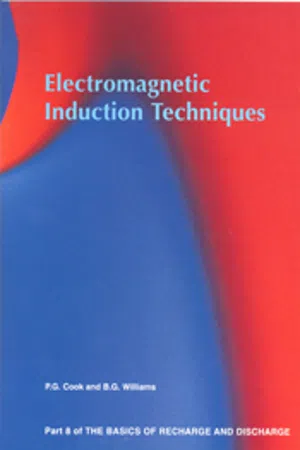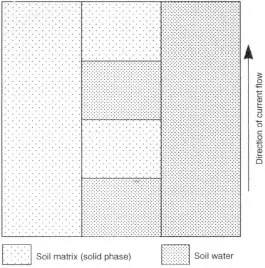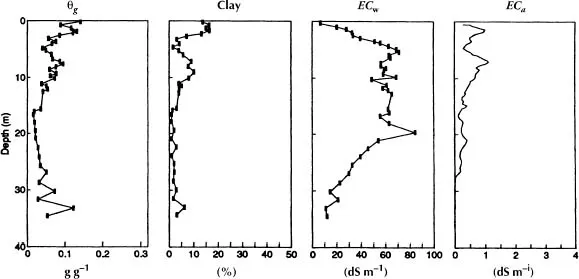
eBook - ePub
Electromagnetic Induction Techniques - Part 8
PG Cook,BG Williams
This is a test
- 20 Seiten
- English
- ePUB (handyfreundlich)
- Über iOS und Android verfügbar
eBook - ePub
Electromagnetic Induction Techniques - Part 8
PG Cook,BG Williams
Angaben zum Buch
Buchvorschau
Inhaltsverzeichnis
Quellenangaben
Über dieses Buch
Electromagnetic induction (EM) techniques are used in recharge/discharge studies by providing measurements of the apparent electrical conductivity of soil profiles. This booklet provides a summary of EM techniques that are most widely used. A number of case studies are presented which demonstrate the applications of the techniques to field problems.
Häufig gestellte Fragen
Wie kann ich mein Abo kündigen?
Gehe einfach zum Kontobereich in den Einstellungen und klicke auf „Abo kündigen“ – ganz einfach. Nachdem du gekündigt hast, bleibt deine Mitgliedschaft für den verbleibenden Abozeitraum, den du bereits bezahlt hast, aktiv. Mehr Informationen hier.
(Wie) Kann ich Bücher herunterladen?
Derzeit stehen all unsere auf Mobilgeräte reagierenden ePub-Bücher zum Download über die App zur Verfügung. Die meisten unserer PDFs stehen ebenfalls zum Download bereit; wir arbeiten daran, auch die übrigen PDFs zum Download anzubieten, bei denen dies aktuell noch nicht möglich ist. Weitere Informationen hier.
Welcher Unterschied besteht bei den Preisen zwischen den Aboplänen?
Mit beiden Aboplänen erhältst du vollen Zugang zur Bibliothek und allen Funktionen von Perlego. Die einzigen Unterschiede bestehen im Preis und dem Abozeitraum: Mit dem Jahresabo sparst du auf 12 Monate gerechnet im Vergleich zum Monatsabo rund 30 %.
Was ist Perlego?
Wir sind ein Online-Abodienst für Lehrbücher, bei dem du für weniger als den Preis eines einzelnen Buches pro Monat Zugang zu einer ganzen Online-Bibliothek erhältst. Mit über 1 Million Büchern zu über 1.000 verschiedenen Themen haben wir bestimmt alles, was du brauchst! Weitere Informationen hier.
Unterstützt Perlego Text-zu-Sprache?
Achte auf das Symbol zum Vorlesen in deinem nächsten Buch, um zu sehen, ob du es dir auch anhören kannst. Bei diesem Tool wird dir Text laut vorgelesen, wobei der Text beim Vorlesen auch grafisch hervorgehoben wird. Du kannst das Vorlesen jederzeit anhalten, beschleunigen und verlangsamen. Weitere Informationen hier.
Ist Electromagnetic Induction Techniques - Part 8 als Online-PDF/ePub verfügbar?
Ja, du hast Zugang zu Electromagnetic Induction Techniques - Part 8 von PG Cook,BG Williams im PDF- und/oder ePub-Format sowie zu anderen beliebten Büchern aus Technik & Maschinenbau & Maschinenbau Allgemein. Aus unserem Katalog stehen dir über 1 Million Bücher zur Verfügung.
Information
ABSTRACT
Groundwater recharge and discharge are two components of the hydrological cycle that are difficult to quantify. However, their measurement is often important in salinity investigations and for the development of predictive models. A part of this problem is the time and cost involved in making sufficient direct measurements to cover the inherent spatial variability of soils and landscapes. Consequently, there is an increasing reliance being placed on more rapid indirect methods for interpolating between sites of detailed investigation. A number of geophysical techniques, originally designed for mineral exploration, are now being used for this purpose. In particular, electromagnetic induction (EM) is proving to be a rapid and useful tool in recharge/discharge studies by providing measurements of the apparent electrical conductivity (ECa) of soil profiles.
It should be emphasised at the outset that ECa does not provide a direct measure of soil water flux. Rather, it reflects the result of the combined interactions of soil texture, soluble salt content, water content, and clay mineralogy of a soil profile. One or more of these factors may dominate the value of ECa obtained in particular situations. However, as long as we are aware of that situation, an EM survey can provide a rational basis for more detailed and quantitative measurements of recharge/discharge, as well as the distribution of soluble salts in landscapes.
Here we provide a summary of the EM techniques that are most widely used. A number of case studies are presented which demonstrate the applications of the techniques to field problems.
1 THE ELECTRICAL CONDUCTIVITY OF A SOIL
The electrical conductivity of a soil sample is a function of the soil structure, texture and mineralogy, as well as its water content and salt content (Nadler and Frenkel 1980; Shainbergr et al. 1980).
Sauer et al. (1955) represented the electrical conductivity of a soil by a three element model consisting of:
1. Conduction through the soil solution
2. Conduction through or along the surfaces of particles in contact with one another, and
3. Conduction through alternating layers of particles and solution (Figure 1).

Figure 1. Three element model of electrical conductivity.
Nadler and Frenkel (1980) and Shainberg et al. (1980) have shown that when the electrical conductivity of the soil solution exceeds about 4 dS/m, the bulk soil conductivity (ECa) becomes directly proportional to the soil solution conductivity and may be approximated by
ECa = ECw. θv. T + ECs | (1) |
where ECwis the electrical conductivity of the soil solution, θv is the volumetric water content, T is the tortuosity, and ECs is the solid phase contribution to the apparent electrical conductivity.
This simple model has been validated by a range of empirical studies (e.g. Rhoades and Ingvalson 1971; Gupta and Hanks 1972). At low ECa values, however, the more sophisticated models of Sauer et al. (1955) and Rhoades et al. (1989) should be considered.
Electrical Conductivity of Soil Solution ECw
Pore water may be extracted from soil samples by a variety of centrifuge and non-polar liquid displacement techniques. However, these are time consuming and the more usual technique is to measure the electrical conductivity of a water extract of the soil (e.g. a 1:5 soil:water dilution) and then adjust that value for the initial soil water content.

Methods based on analyses of single ions (e.g. Cl) should be used with some caution because different salts have different electrical conductivities. It is a relatively uncommon situation to find just a single salt, such as NaCl, presenr in a soil solution alrhough there are siruarions where it has been shown to represent a very large proporrion of the soluble salts present (Johnston et al. 1982). NaCl, CaCl2, MgCI2, and Na2S04 have similar EC:concentration relationships, but MgS04, CaS04, and NaHC03 have lower EC values for equivalenr salr concenrrarions.

Volumetric water content (θv)
The paramerer θv is usually esrimared by multiplying the measured gravimertic warer content (grams of warer per gram of dry soil) by an assumed soil bulk density (g cm−3). Again, care needs ro be exercised in the choice o f values for bulk density as they may vary from as low as 1.15 g cm−3 to greater than 1.65 g cm–3 down a single profile.
Tortuosity (T)
The tortuosity factor (0<T<1) is a function of the soil texture, structure and water content, and it is not easily measured. For a saturated soil it may be assumed to be constant at 0.65 (Penman 1940), and a linear relationship with water content is also often assumed (Johnston 1987). Table 1 provides a guide to commonly used values.
The parameter (T) represents the ratio of the length of the direct (straight line) path of an electric current through the soil, to the length of path the electric current must take as it travels through the interstitial solution. As the water content decreases, the path length for current flow increases, and hence the tortuosity decreases. The term ‘tortuosity’ is probably not particularly well chosen in the sense that a highly ‘tortuous’ path is represented by low values of T.
Solid phase conductivity (ECS)
The solid phase contribution to the total apparent electrical conductivity is due largely to the presence of exchangeable ions on the surface of clay particles (Nadler and Frenkel 1980). ECS can be estimated by extrapolating the linear portion of the ECa versus ECw relationship to ECw = 0. Rhoades (1981) carried out such an exercise for 12 Arizona and California soils, and found ECS to be well correlated with clay content. He determined the empirical relationship:
ECs = 0.0247 C − 0.0236 | (3) |
R2 = 94%
where C is the clay percentage and ECs has units of dS m−1.
If the component ECs is small in relation to the remainder of Equation 1, as is often the case in saturated systems, then (θvT)−1 is analogous to the formation factor (F) used by groundwater geophysicists (Park and Dickey 1989).
ECa = ECwF–1 | (4) |
Empirically derived values of F for a range of geological systems are given in most geophysical texts (e.g. Keller and Frischknecht 1966). However, these values generally pertain to consolidated rock materials, so for soils we prefer the less empirical approach embodied in Equation 1,
Relative effects of Equation 1 components
According to this model the apparent electrical conductivity of a soil will increase if the salt concentration of the soil solution, the volumetric water content, or the clay content of the soil increases. It will be noted that
salt concentration X water content = total salt
Hence, the use of ECa measurements for salinity surveys can also be appreciated (e.g. Williams and Baker 1982; Williams and Hoey 1987).
Using the conversion values for θv T and ECs discussed above, together with an ECw value of 5 dS m−1, the following approximate values of ECa could be expected (Table 2).


Figure 2. Profiles of measured soil properties.
Case study 1
Cook et al. (1992) measu...